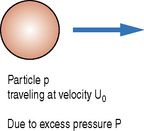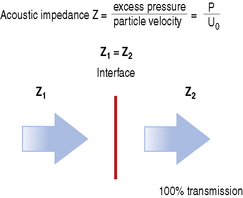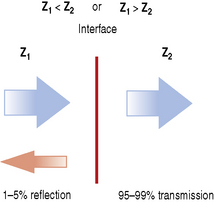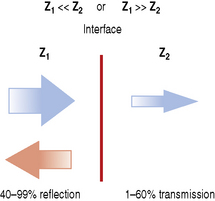Chapter 4 Acoustic impedance
Acoustic impedance (Z) is the property of a substance, which describes how the particles of that substance behave when subjected to a pressure wave, i.e. a sound wave. Acoustic impedance gives the relationship between excess pressure P and particle velocity U0 as shown in Figure 4.1.

Fig. 4.1 A particle subjected to excess pressure P traveling at velocity U0. This gives the acoustic impedance formula:

If the substance has densely packed particles, for example bone, then it will take a high excess pressure for them to move at a given velocity. Therefore this type of substance will have high acoustic impedance.
On the other hand if the substance has loosely packed particles, for example air, then it will take a much lower excess pressure for them to move at the same velocity. Therefore this type of substance will have low acoustic impedance.
Acoustic impedance gives a measure of the resistance a substance has to the propagation of a sound wave through it. It is normally calculated from density ρ and speed of sound c as follows:
| density ρ | kg/m3 |
| speed of sound c | m/s |
| acoustic impedance Z | rayls (= kg/m2/s) |
In this book, speed and velocity have the same meaning. The acoustic impedance of various substances is given in Table 4.1.
Table 4.1 The acoustic impedance of various substances
| Substance | Acoustic Impedance in Megarayls (kg/m2/s) × 106 | Speed (m/s) |
|---|---|---|
| Air | 0.0004 | 330 |
| Fat | 1.38 | 1450 |
| Water | 1.48 | 1480 |
| Blood | 1.61 | 1570 |
| Kidney | 1.62 | 1560 |
| Liver | 1.65 | 1550 |
| Muscle | 1.70 | 1580 |
| Soft tissue (average) | 1.63 | 1540 |
| Bone | 7.80 | 3500 |
| PZT (Crystal) | 30 | 3870 |
Note: the acoustic impedances of air and bone are very different.
ACOUSTIC IMPEDANCE AND REFLECTION
When an ultrasound beam strikes an interface between substances it is the acoustic impedances of the two substances that determine whether reflection takes place and the amount of energy reflected. The examples below illustrate this.
In substances with the same acoustic impedance there is total transmission of energy and therefore no reflection, see Figure 4.2.

Fig. 4.2 Total transmission of ultrasound energy as it passes across an interface between two substances of the same acoustic impedance
In substances with a small difference in acoustic impedance a small amount of energy is reflected but the majority is transmitted, see Figure 4.3.

Fig. 4.3 A small amount of reflected energy and a large amount of transmitted energy as ultrasound passes across an interface between two substances with a small difference in acoustic impedance
In substances with a large difference in acoustic impedance there is a large amount of reflected energy and a small amount of transmitted energy, see Figure 4.4.
INTENSITY REFLECTION COEFFICIENT
This gives the proportion of energy reflected from an interface between two substances and has a value between 0 and 1, where 0 = total transmission and 1 = total reflection.
The intensity reflection coefficient for various interfaces is given in Table 4.2.
Table 4.2 The intensity reflection coefficient for various interfaces
| Interface | Intensity Reflection Coefficient R | Percentage of Energy Reflected (%R) |
|---|---|---|
| Fat/Muscle | 0.0108 | 1.08 |
| Bone/Muscle | 0.412 | 41.2 |
| Air/Soft tissue | 0.999 | 99.9 |
Note the high reflection coefficients for bone/muscle and air/soft tissue.
For most soft tissue/soft-tissue interfaces the percentage of energy reflected is 1% or less.
THE INTENSITY REFLECTION EQUATION
This equation allows you to calculate the intensity reflection coefficient (R) for an interface between two substances providing you know their acoustic impedances.
| Ir = reflected intensity |
| Ii = transmitted intensity |
| Z1 and Z2 = acoustic impedances of the two substances |
What is the intensity reflection coefficient R for an interface between liver (Z1 = 1.65 Mrayls) and fat (Z2 = 1.35 Mrayls)?
ACOUSTIC IMPEDANCE AND ULTRASOUND IMAGING
The difference in acoustic impedance between two substances is known as the acoustic impedance mismatch. It is this acoustic impedance mismatch at an interface which is responsible for ultrasound energy being reflected back toward the probe and being used to produce an image.
If there is a large acoustic mismatch, e.g. between bone and muscle or air and soft tissue, then a large proportion of energy is reflected. This results in a strong echo, which produces a bright image on the display. However, very little energy is transmitted across the interface and any echoes produced beyond the interface do not have enough energy to produce an image, see Figure 4.5.
If the acoustic impedance mismatch is small, e.g. between two soft tissues, then a small proportion of energy (1% or less) is reflected. The rest of the energy is transmitted across the interface to produce further echoes from other interfaces deeper within the subject, see Figure 4.6.
From the above it can be seen that where there is a large acoustic impedance mismatch across an interface, ultrasound will not produce a useful image beyond that interface. Therefore it is not practical to use ultrasound to produce images of soft-tissue subjects which contain gas or bone. However, ultrasound imaging is very good at discriminating between substances with small differences in acoustic impedance and is therefore excellent at differentiating between different types of soft tissues.





